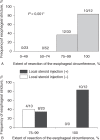Effect of endoscopic submucosal dissection for superficial esophageal neoplasms and risk factors for postoperative stricture
- PMID: 25569662
- PMCID: PMC4602840
- DOI: 10.1097/MD.0000000000000373
Effect of endoscopic submucosal dissection for superficial esophageal neoplasms and risk factors for postoperative stricture
Abstract
Endoscopic submucosal dissection (ESD) enables wider tumor resection compared with endoscopic mucosal resection and en bloc resection of superficial esophageal neoplasms. However, ESD may cause difficult-to-treat stricture of the esophagus, and therefore, prediction of and measures against postoperative esophageal stricture are critical. The aim of this study was to evaluate the effect of ESD on superficial esophageal neoplasms and identify risk factors associated with esophageal stricture after ESD.This study included 165 lesions in 120 patients with superficial esophageal neoplasms, including cancer and neoplasia, who underwent ESD from 2009 to 2013.The complete resection rate of superficial esophageal neoplasms by ESD was 90.9%. After ESD, 22 subjects (18.3%) had symptomatic esophageal stricture, 12 (10.0%) had aspiration pneumonia of grade 2, and 7 (5.8%) had mediastinal emphysema of grade 2. Comparison of the 22 subjects with stricture with the 98 subjects without stricture showed significant differences in the rate of resection of >75% of the esophageal circumference, rate of whole circumference resection, and the required time for resection. The tumor size and the size of the resected tissue sample also differed between the 2 groups. The groups did not differ in age, sex, alcohol intake, and smoking; location, macroscopic, and histological tumor findings; chest pain; or use of anticoagulants for comorbidities. In multivariate analysis, tumor size and whole circumference resection were independent risk factors for stricture. Furthermore, in 45 subjects with resection of >75% of the esophageal circumference, whole resection of the esophagus was the only independent risk factor for stricture.This study suggests that ESD has a strong therapeutic effect on superficial esophageal neoplasms; however, a greater extent of resection of the esophagus increases the risk of postoperative esophageal stricture. Preventive measures against development of postoperative stricture require further study.
Conflict of interest statement
The authors have no conflicts of interest to disclose.
Figures


References
-
- Herszényi L, Tulassay Z. Epidemiology of gastrointestinal and liver tumors. Eur Rev Med Pharmacol Sci 2010; 14:249–258. - PubMed
-
- Holmes RS, Vaughan TL. Epidemiology and pathogenesis of esophageal cancer. Semin Radiat Oncol 2007; 17:2–9. - PubMed
-
- Hongo M, Nagasaki Y, Shoji T. Epidemiology of esophageal cancer: Orient to Occident. Effects of chronology, geography and ethnicity. J Gastroenterol Hepatol 2009; 24:729–735. - PubMed
-
- Fujishiro M, Yahagi N, Kakushima N, et al. Endoscopic submucosal dissection of esophageal squamous cell neoplasms. Clin Gastroenterol Hepatol 2006; 4:688–694. - PubMed
Publication types
MeSH terms
LinkOut - more resources
Full Text Sources
Medical
Research Materials
Miscellaneous

